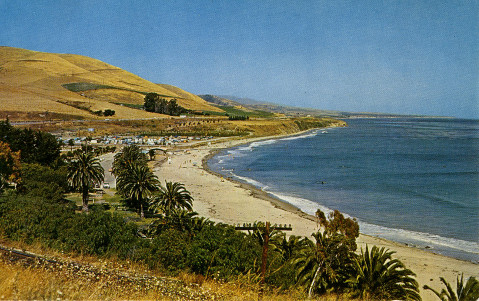
The first influx of Japanese immigration to Santa Barbara County took place in the years around 1900. Within a couple of decades Santa Barbara’s Mesa was dotted with Japanese flower and produce fields. Yet the first Japanese arrived on the South Coast in 1815, after a harrowing journey across the Pacific.
The Tokujō-maru was a large cargo ship used in the rice trade among the islands of Japan. In October 1813, it left port under the command of a Captain Jūkichi. These cargo ships were unwieldy craft, ideal for navigating the shallow waters around Japan but singularly unfit for deep-water voyages.
The outbound trip was uneventful, but the return was a disaster. A large storm blew the ship out to sea. Huge swells broke the rudder and gale-force winds forced the crew to cut down the mast. The ship was now at the mercy of wind and currents which took it south and ever eastward.
The ship’s supply of rice and soybeans had to be carefully rationed and was supplemented by fish. The crew fashioned a device to distill seawater for drinking. The New Year went by without sight of land. By March hope was fading. Crew members sickened; the first died early in May, and by late June only Jūkichi and two crewmen remained.
The ordeal continued. As 1814 passed into 1815, the two crewmen visibly weakened. On January 26, Jūkichi had thought he had seen some mountaintops on the horizon, but the ship was taken in the opposite direction. At this point even Jūkichi, who had done all he could to keep morale up, was losing hope.
On March 24, 17 months after setting out, sails appeared on the horizon. It was the brig Forester, captained by William J. Pigot. The Forester, engaged in the fur trade, had wintered off the California coast and was preparing to move back to Alaskan waters when it came upon the Japanese hulk about 300 miles west of Point Conception.
The Forester made for the mainland. Exactly where Pigot put in remains a bit of a mystery, although it was most probably near the Ortega family’s Rancho Refugio. Jūkichi accompanied the landing party, believing he was back in Japan. A party of some 15 horsemen greeted them; Jūkichi thought they were Dutch, the only Westerners allowed in Japan at that time. Mounting a horse for the first time, he rode some three miles to an adobe house.
During his 10-day sojourn, Jūkichi was told he was in a place called New Spain. He was enchanted by the costumes worn by the women but repelled by the slaughter of cattle and other animals for food, which was rarely seen in largely Buddhist Japan. The Ortegas had the two crewmen brought ashore for treatment, and their condition rapidly improved.
After re-victualing, the Forester sailed off with its three passengers to Alaska, then the Kamchatka Peninsula in Russia, where it wintered. In May 1816, aboard a Russian vessel, the three headed for home. One died during the voyage, but in July the two survivors saw the Japanese shoreline once again.
Jūkichi lived out the rest of his life in virtual seclusion and financial hardship. To many, his contact with foreigners made him suspect. He spent many years raising funds to erect a memorial to the crew of the Tokujō-maru. The first Japanese to set foot on the South Coast died in 1853.



